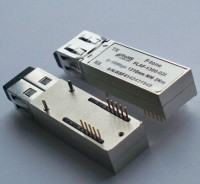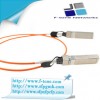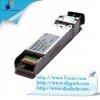兼容光模块

PT7323-32-1
Specifications
- 产品型号: PT7323-32-1
- 兼容品牌: 飞通NeoPhotonics
- 封装类型: SFF
- 传输速率: 155Mb/s Single Mode
- 传输距离: 30km with 9/125µm single mode fiber
- 发射波长: 1310nm
- 接收波长: 1310nm
- 工作温度: 商业级0℃~+70℃/工业级-40℃~+85℃ 可选
- 数字诊断: 带DDM/不带DDM 可选
- 接收灵敏度: 30km with 9/125µm single mode fiber
- 接收灵敏度: 30km with 9/125µm single mode fiber
Description
PT7323-31-1
Small Form Factor 155Mb/s Single Mode 2×5 Transceiver
1 Features
1.1 Transceiver unit with independent
1310nm MQW FP Laser diode transmitter
InGaAs PIN photodiode receiver
1.2 Meet SFF MSA with duplex LC receptacle
1.3 Metal enclosure for lower EMI
1.4 +3.3V Single power supply
1.5 Qualified to meet the intentof Bellcore reliability practices
1.6 LVPECL logic interface simplifies interface to external circuitry
1.7 Links of 30km with 9/125µm single mode fiber (SMF)
2 Applications
2.1 SONET OC-3 IR-1 / SDH STM S-1.1
2.2 Fast Ethernet
3 General
PT7323 transceiver is a high performance, cost effective module for serial optical data communication
application.
3.1 Transmitter Section
Transmitter is designed for single mode fiber and operates at a nominal wavelength of 1310nm. The
transmitter module uses a MQW FP laser diode and full IEC825 and CDRH class 1 eye safety. The
output optical power can be disabled via the single TxDis pin. Logic LVTTL HIGH level disables the
transmitter. It contains APC function, temperature compensation circuit, PECL data inputs, LVTTL TxDis
input interface.
3.2 Receiver Section
The receiver section uses a hermetic packaged PINTIA (InGaAs PIN and trans-impendence amplifier)
and a limiting amplifier. Which transforms input optical power to optical current through PIN PD. And the
optical current is transformed to voltage signal bytrans-impendence amplifier. Differential DATA and
/DATA LVPECL data signal that is open emitter output is produced by limiting amplifier and voltage
signal that is through limiting amplifier and filter. The receiver signal detect monitors input optical signal.
When the optical power is not enough to support module operating normally, SD pin will beat LVPECL
logic level 0 and signal detect appears. The PINTIA is ac coupled to limiting amplifier through a low pass
filter. The LPF are enough to pass the signal from 5Mb/s to 200Mb/s without significant distortion or
performance penalty.
3.3 Power Supply Filtering and Ground Planes
It is important to exercise care in circuit board layout to achieve optimum performance from these
transceivers. It is further recommended that a continuous ground plane be provided in the circuit board
directly under the transceiver to provide a low inductance ground for signal return current.
3.4 Electromagnetic Interference (EMI)
One of a circuit board designer’s foremost concerns is the control of electromagnetic equipment.
Success in controlling generated Electromagnetic Interference (EMI) enables the designer to pass a
governmental agency’s EMI regulatory standard and more importantly, it reduces the possibility of
interference to neighboring equipment. PT7323 provides excellent EMI performance. PHOTON LC
transceiver use forward and backward shields, which obturates the interstice of LC module effectually,
and improves EMI performance.
3.5 Application Note
There are a few fundamental guidelines to follow when designing the PT7323 circuit interface. On the
board, every data connection should be an impedance match. The data inputs and outputs lines should
be treaded as 50ohm microstrip line, and vias should be avoided. The matching resistor should be
placed at the end of each matched line. The PT7323 is high frequency, high bandwidth circuits. To
ensure stability, use good high frequency layout techniques, filter voltage circuit, and keep ground
connections short.
4 Performance Specifications
Caution:stresses in excess of the absolute maximum ratings can cause catastrophic damage to the
device, all parameters having values within the recommended operating conditions.


